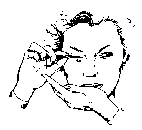< Page 7 of 9 >
1 2 3 4 5 6 7 8 9
Contact Lens Instruction
Insertion Techniques:
Many patients experience difficulty with lens insertion in the beginning.
Informing the patient of this can help instill confidence in the event
the first few attempts at lens insertion are not met with success. Let
them know that lens insertion is a skill which needs to be learned.
The following training techniques will prove helpful in assisting the
new patient. 
-
Keep the elbows out while inserting the lens. If they are positioned too far in, toward the body, it may restrict the movement of the index finger into the space between the lids.
-
The lower lid should be held down with the middle finger of the dominant hand while the upper lid is held with the middle finger of the other hand. Holding the lids apart creates an opening large enough to accommodate the lens and it delays the normal blinking reflex.
-
While inserting the lens the patient should look straight ahead. At first, a mirror should be used so the patient can actually watch the lens as it is applied to the cornea. Eventually, if the patient continues to look straight ahead during the insertion process, a mirror will not be necessary.
-
If after several tries, your patient continues to experience difficulty inserting the lenses, it might be best to leave the room and let the patient continue alone. Some people are simply more at ease practicing alone.
-
If difficulty is still experienced, have the patient use the two-handed technique as described above. But this time to touch the cornea with the index finger with no lens present. This can sometimes help to instill confidence.
Removal Techniques
for Soft Lenses:

-
The patient should look straight ahead at a spot directly in front.
-
The gaze should then be directed upward, being sure not to move the head.
-
Pull the lids apart in a manner similar to the technique used to insert the lens.
-
Gently slide the lens straight down from the cornea to the sclera with the index finger of the dominant hand.
- While the lens
is being held on the sclera by the index finger, bring the thumb onto
the eye and gently pinch
the lens out.
Removal Techniques for Hard Lenses:
-
The lens should be centered on the cornea.

-
Open the eye wide enough so that the edges of the lens are not in contact with the eyelids. Then pull the outer corner of the eyelids slightly to make them tight.
-
Quickly blink in an effort to remove the lens from the cornea as the result of a bumping action created by the eyelids. While the opposite hand covers the eye to catch the lens, it is recommended that a tissue or soft cloth is used to cushion the lens in the event it falls.
Breaking-In Wearing
Schedules
PMMA: PMMA lenses should be worn no more than two to three hours
the first day with the wearing time gradually increased one hour per day.
They should be worn no more than eight hours in a single day until the
patient can be seen for a follow up visit. However the lenses should only
be worn for as long as they are comfortable.However as in the case of
all contact lenses, the lenses shoiuld only be worn for as long as they
are comfortable.
Gas Permeable: These lenses can generally be worn about four hours the first day, increasing the wearing schedule two hours each day for as long as they remain comfortable. If prolonged wearing time results in decreased comfort, the wearing time should be limited so that it does not exceed the point of comfort. In many cases the lenses can eventually be worn from 12 to 18 hours per day, provided they remain comfortable and the eyes are not red. Unless they are specifically approved and prescribed for extended wear purposes, the lenses should not be worn overnight, regardless of how comfortable they may feel. Normal adaptive symptoms of RGP lenses include slight scleral injection, excessive blinking, and tearing.
Soft Contact Lenses: Initial wearing schedules can vary. However on a healthy eye, a well fit lens can sometimes be worn for a full day right from the start. A more conservative schedule might indicate six hours the first day, with an increase of four hours each day until a maximum of eighteen hours is reached. Again, the lenses should never be worn beyond the period of comfort. Should the lenses become very uncomfortable, they should be removed and a follow up visit scheduled.
< Page 7 of 9 >
1 2 3 4 5 6 7 8 9